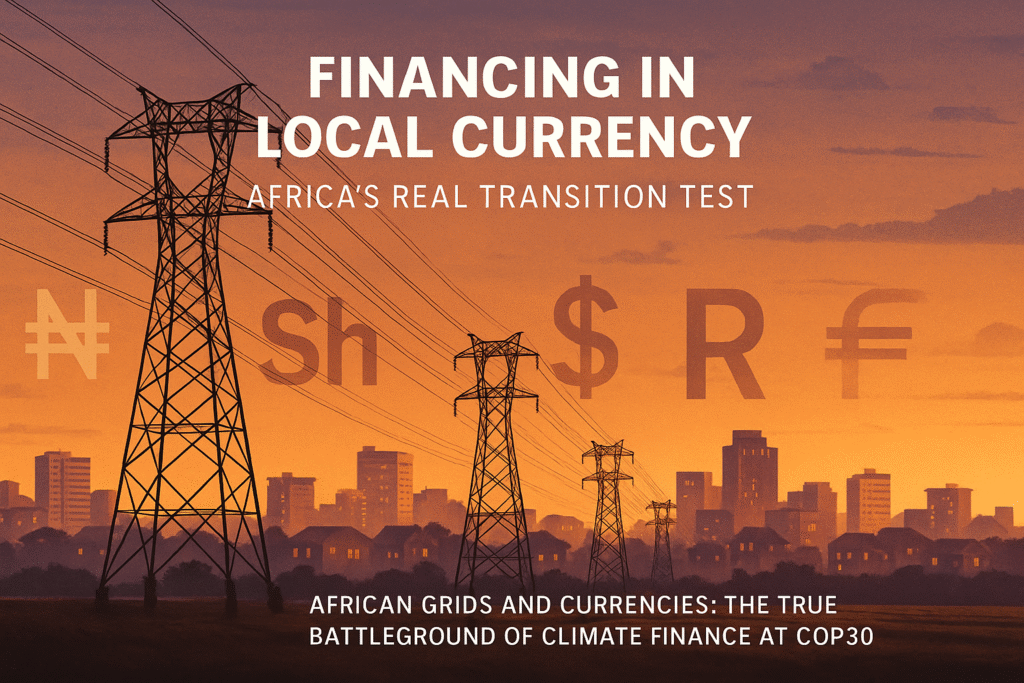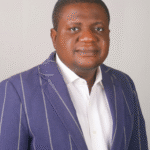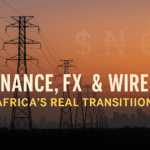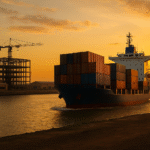À première vue, la transition énergétique africaine semble enfin s'accélérer. Les importations d'énergie solaire atteignent des niveaux records, des parcs éoliens fleurissent au Sahel et les projets hydroélectriques sont modernisés. Pourtant, dans les tableaux de bord des ministères et des promoteurs se cache une réalité plus inquiétante : le coût du capital en Afrique demeure parmi les plus élevés au monde.
Le paradoxe est cruel. L'énergie solaire et éolienne sont moins chères que les énergies fossiles presque partout, mais dans les pays africains, le financement des projets est systématiquement plus onéreux que celui des projets à charbon en Asie ou à gaz en Europe. Le problème ne vient ni des turbines ni des panneaux solaires, mais de la monnaie. Les projets d'énergie propre sont chiffrés en dollars ou en euros, tandis que les revenus sont versés en nairas, en shillings ou en rands. La volatilité et la dépréciation des taux de change contraignent les financeurs à exiger des primes exorbitantes, ce qui entraîne une hausse des tarifs et compromet l'accessibilité financière.
Alors que les négociateurs se préparent pour la COP30, le Groupe africain de négociateurs (GAN) devrait exiger un financement en monnaie locale. Sans outils pour atténuer le risque de change, les promesses de financement climatique paraîtront importantes dans les communiqués, mais resteront insuffisantes pour les communautés.
Pourquoi les dollars ne fonctionnent pas pour l'Afrique
Les fonds internationaux pour le climat et les banques multilatérales de développement accordent généralement des prêts en devises fortes. De leur point de vue, c'est logique : prêter en dollars ou en euros réduit leurs coûts d'emprunt et leur exposition au risque. Mais pour les gouvernements et les entreprises de services publics africains, ce décalage est catastrophique.
Prenons l'exemple d'une centrale solaire au Nigéria financée en dollars. Lorsque le naira se déprécie, comme cela s'est produit à plusieurs reprises, le coût du service de la dette explose en monnaie locale. Les fournisseurs d'électricité doivent alors soit augmenter fortement leurs tarifs, soit accepter des pertes, soit renégocier leurs contrats. Le projet, autrefois viable sur le papier, devient un fardeau. Les communautés locales en subissent les conséquences, soit par des factures d'électricité plus élevées, soit par des coupures de courant persistantes.
Il ne s’agit pas d’un problème isolé. La Banque africaine de développement (BAD) souligne que le risque de change à lui seul peut faire grimper les tarifs des énergies renouvelables jusqu’à 301 000 milliards de pesos, annulant ainsi l’avantage concurrentiel des panneaux solaires ou des éoliennes bon marché. Des études récentes du Energy for Growth Hub montrent que… Le financement en monnaie locale pourrait réduire le coût du capital pour les énergies renouvelables jusqu'à 311 TP3T. et réduire les prix de l'électricité livrée de près d'un tiers. Pour un continent où plus de 600 millions de personnes n'ont toujours pas accès à l'électricité, ces pourcentages se traduisent par des gains ou des pertes en termes de contrats à terme.
Le piège de la dette dans le financement climatique
Il y a aussi la question plus large de la dette. Selon Climate Policy Initiative, L’Afrique a besoin d’environ 1 600 à 1 900 milliards de dollars d’investissements climatiques d’ici à 2030., mais seule une fraction de cette somme arrive. Pire encore, une grande partie de ce qui arrive est sous forme de prêts. En 2022, plus de la moitié du financement climatique de l'Afrique était constitué de dettes., Il ne s'agit pas de subventions. Alors que le surendettement est déjà largement répandu, l'octroi de prêts en dollars à des économies fragiles risque d'aggraver les vulnérabilités mêmes que le financement climatique est censé résoudre.
C’est pourquoi les négociateurs africains devraient affirmer que la justice climatique ne peut être rendue avec la même monnaie qui alimente les crises de la dette. Financer en monnaie locale ne vise pas seulement à réduire les primes de risque, mais aussi à garantir la souveraineté. Si la COP30 aboutit à une nouvelle série d’engagements libellés en dollars sans modifier les flux de capitaux, le continent restera prisonnier d’un cycle de promesses vaines.
La justice climatique ne peut être rendue avec la même monnaie qui alimente les crises de la dette.
À quoi ressemble la finance en monnaie locale
La demande est claire : il faut créer des guichets de prêt à taux préférentiels et des garanties autour des prêts en monnaie locale. Cela va bien au-delà des projets pilotes. Un changement institutionnel s’impose.
- obligations vertes en monnaie localeLes banques de développement et les trésoreries africaines peuvent émettre des obligations en shillings, en nairas ou en francs CFA, assorties de garanties internationales. Cela permet aux investisseurs d'entrer sur le marché sans s'exposer au risque de change, tandis que les projets locaux empruntent dans leur propre monnaie.
- mécanismes de couverture de changeÉtendre des plateformes comme TCX (The Currency Exchange Fund) aux énergies renouvelables africaines pourrait protéger les développeurs contre les dévaluations soudaines. Actuellement, la couverture est trop coûteuse ou indisponible sur de nombreux marchés.
- Mise en commun régionaleLe risque de change peut être partagé au niveau régional par le biais d'institutions financières africaines qui regroupent les projets et répartissent l'exposition aux devises, réduisant ainsi les coûts.
- Réformes des banques de développementLes agences de la BAD, de la SFI et de la Banque mondiale devraient accroître considérablement leurs prêts en monnaie locale, non pas comme des instruments de niche, mais comme des services essentiels. Cela implique d'accepter une part du risque de change dans le cadre de leur mandat de développement.
Le réseau comme garantie
Le financement en monnaie locale doit s'accompagner d'investissements dans le réseau électrique. Le risque de change et la faiblesse des infrastructures constituent deux obstacles majeurs. Même lorsque les panneaux solaires sont bon marché et les prêts avantageux, l'électricité ne peut circuler sans câbles. Estimations de la BAD L'Afrique a besoin de 1 046 000 milliards de dollars par an jusqu'en 2030. juste pour parvenir à un accès universel, la majeure partie du travail concerne la transmission et la distribution.
Le lien est simple : les investisseurs sont plus à l'aise pour prêter en monnaie locale lorsqu'ils constatent des flux de revenus nationaux robustes. Si les services publics restent en faillite et les réseaux électriques défaillants, Aucune devise ne garantit la viabilité financière des projets. Par conséquent, la modernisation du réseau électrique constitue en elle-même une forme de réduction des risques, une garantie tangible du remboursement des prêts en monnaie locale.
Leçons de Komati
La centrale à charbon de Komati en Afrique du Sud, mise hors service en 2022, est devenue un cas d'école. Financée par des prêts à taux préférentiels, sa reconversion était censée symboliser une transition juste. Or, les décaissements ont tardé, les retombées locales ont été lentes et les communautés ont eu le sentiment que les promesses étaient restées lettre morte. L'examen de juin 2025 de la Commission présidentielle sur le climat a mis en lumière les risques liés à une mauvaise planification des financements.
La leçon de la COP30 est sans équivoque : financer les transitions en devises étrangères, avec des décaissements lents et conditionnels, ne peut constituer un modèle viable. Les collectivités exigent des avantages concrets et immédiats, en termes locaux. Cela signifie que les emplois, les marchés publics et les services sont financés avec l’argent qu’ils utilisent réellement.
Ce que l'Afrique devrait exiger à la COP30
- Fenêtre de change et de grille à périmètre défini : Une partie du Nouvel Objectif Collectif Quantifié (NCQG) sur le financement climatique devrait être réservée aux prêts en monnaie locale et aux infrastructures de réseau.
- Installations en monnaie locale adaptées : Les banques de développement doivent étendre leurs activités au-delà des projets pilotes de couverture spécialisés et des prêts climatiques classiques en monnaie locale.
- Métriques d'accès : Les financements concessionnels doivent être liés non seulement aux gigawatts installés, mais aussi à l'accès à des logements et des PME à des tarifs abordables.
- Mesures de protection contre la dette : Tout nouveau financement sous forme de prêt doit être évalué au regard de la viabilité de la dette ; les subventions et les garanties doivent être privilégiées.
Voici les grandes lignes d'un accord crédible. Sans cela, les négociateurs africains ne devraient pas troquer des engagements vagues contre des promesses vagues concernant l'abandon progressif des énergies fossiles.
La transition énergétique de l'Afrique ne se fondera pas sur la dette en dollars ; elle doit être financée avec la monnaie que les gens utilisent réellement.
Pourquoi cela est important pour tout le monde
La transition de l'Afrique n'est pas un sujet secondaire. Avec un tiers des minéraux critiques mondiaux, Avec son immense potentiel solaire et sa population en forte croissance, le continent africain façonnera l'équilibre énergétique mondial. Si sa transition est freinée par l'endettement et les risques de change, les objectifs mondiaux de limitation du réchauffement climatique à 1,5 °C seront compromis. En revanche, s'il réussit sa transition grâce à des financements en monnaie locale et à des réseaux électriques résilients, il pourra devenir un pilier de l'approvisionnement en énergie propre et abordable pour les décennies à venir.
Suivre Transition énergétique en Afrique pour plus de mises à jour :
![]()
![]()
Vincent Egoro est une voix africaine de premier plan en matière de transition énergétique juste, d'élimination progressive des combustibles fossiles et de gouvernance des minéraux critiques. Fort de plus de dix ans d'expérience en plaidoyer régional, il œuvre à l'intersection de la transparence, de la responsabilité et de la durabilité, promouvant des solutions communautaires qui placent l'Afrique au cœur de l'action climatique mondiale.




Pingback: Le prix de l'énergie : pourquoi l'avenir énergétique propre de l'Afrique dépend encore de financements extérieurs - Transition énergétique Afrique Le prix de l'énergie : la transition énergétique de l'Afrique financée par l'étranger